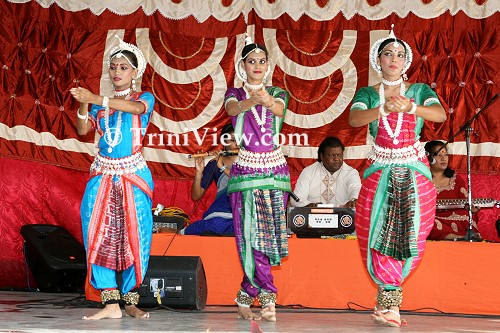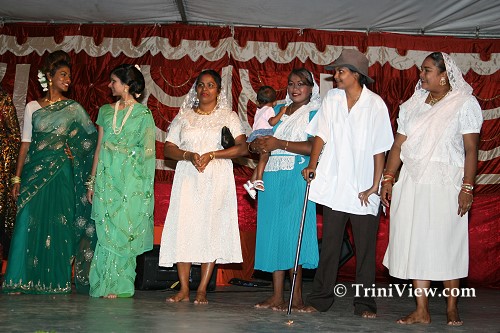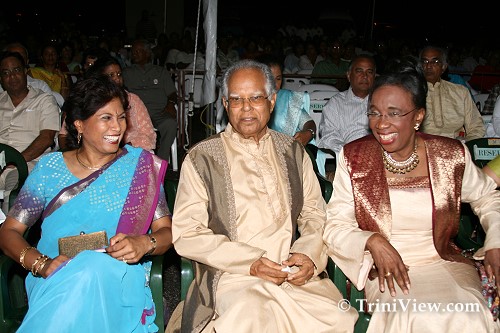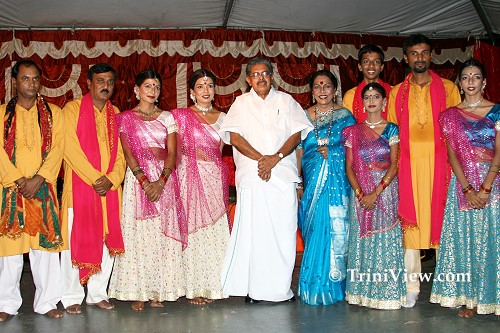 Classical Indian dancers do an invocation dance
Classical Indian dancers do an invocation dance
TriniView.com Reporters
Event Date: May 30, 2007
Posted: June 07, 2007
The National Council for Indian Culture (NCIC) held its Indian Arrival Day Celebrations at the Divali Nagar Site in Chaguanas. Indian Arrival Day celebrates the arrival of Indians to Trinidad from India under the British led Indentureship programme that was initiated to address the labour shortages that arose from Africans leaving the plantation after Emancipation.
The first boat, the Fatel Razack, crossed the "kali pani" (dark water), docking in Trinidad on the 30th of May 1845. The Indians who came were not a homogeneous group as they were from different territories, wore various types of clothes, spoke different languages and dialects of those languages, and were of different castes. They brought to Trinidad various styles of dress, particular plants and food, music, religion, names, and festivals.
The Children of Param Dhaama Ashram in Penal opened the show with a Vedic Mantra. Ravi Bharati informed the audience that they were standing on the shoulders of the ancestors who laid the foundation of their culture and painted the landscape with their traditions, their value systems, their cuisine, their clothing and their language. He mentioned the different types of songs: Lawa, Matikoor and Chutney which were prevalent with their ancestors and are still popular today. He then introduced the Penal-based Rauti Ali Group that has been in existence for twenty years and has kept the musical traditions alive. They delighted the audience with their singing and two females from this group entertained the gathering with some traditional Indian dance moves.
 The Old and New Fashion Segment
The Old and New Fashion Segment
Ravi Bharati shared with the audience the different types of clothing such as the sari, dhoti, kurta, choli, salwar and pagri, which the East Indian indentured workers brought with them from India. Following this, there was a fashion segment consisting of modeling of both old and contemporary fashions. This segment was very well-received by the audience.
Seeromani Naraynsingh and Indra Singh performed two Picharakaree songs including 'Follow Your Nani and Nana'. Later in the programme they also performed the mantra of the year, 'Children of Noble Culture'.
The Kala Sangam Group took to the stage next and delighted the audience with the bright colours and deft dance moves to the sound of traditional Indian music. Ravi Jagroop, accompanied by his father and brothers, proceeded to perform two classical Indian songs.
At about 6 p.m. the NCIC parade arrived at the venue with great pomp. The parade was accompanied by a troop of drummers as well as a loud speaker system fixed to a car which allowed the live singing to be heard by all. Groups such as the Hindu Students Council of Trinidad and Tobago, the Brahma Kumaris Raja Yoga Centre and the Sahaja Yoga Meditation participated in the parade. Boats were a dominant theme in the parade with one big boat being drawn by a trailer while the Brahma Kumaris Raja Yoga Centre creatively used a long strip of brown cloth to represent the arrival of Indians to Trinidad on the boat.
 Minister Christine Sahadeo, NCIC President Deokinanan Sharma and
Minister Christine Sahadeo, NCIC President Deokinanan Sharma and
Minister oc culture Joan Yuille Willams
Deokinanan Sharma, President of the National Council for Indian Culture, delivered the welcome address which began by greeting diplomatic guests: the Minister of Culture, Joan Yuille-Williams; Senator Christine Sahadeo; Chaguanas Mayor Mr. Surujrattan Rambachan; President of Gopio International, Mr. Indar Singh; and the Minister of Overseas Indian Affairs, Mr. Vayalar Ravi. Mr. Sharma highlighted that Indian indentured laborers arrived in response to labour shortages that arose from Africans leaving the plantation after Emancipation. He spoke about the hardships experienced by indentured workers but also noted that about 80 percent opted to stay and would contribute significantly to the economic, social and cultural landscape of Trinidad and Tobago. He pointed out that after 162 years the sugarcane industry, the reason for their coming, came to an unfortunate and inglorious end, leaving local farmers "catching their nenen" and called on the powers that be to look more closely at the effects of this closure.
Surujrattan Rambachan, Mayor of Chaguanas, took to the stage and delighted the audience by singing "Children of Noble Culture". Mr. Rambachan reminded the audience that Indian Arrival Day is an important day and noted that there is no way that the present generation can repay the Indian indentured workers for the legacy they left. He praised them for their wealth, happiness, values and dharma, but lamented the decline in values, blaming the home and parental indifference for this.
Senator Christine Sahadeo, representing Prime Minister Patrick Manning, addressed the audience and remarked that there was a lot to celebrate on Indian Arrival Day, as their ancestors laid the foundations for the progress of this society through industry, thrift, sacrifice and creativity. She remarked that today, "Ours is a nation where no group or individual is denied the opportunity for development; every creed and race does indeed have an equal place." She noted that members of the Indian Diaspora in this country demonstrated impressive entrepreneurship from the beginning, where today they are an important presence in all sectors: small, medium and large. She noted that the economy has been growing at an average of 8.5 percent, creating opportunities for expansion and new initiatives. She also stated that the economy was now at full employment for the very first time which brought loud murmurs of disagreement from the audience.
 Minister of Overseas Indian Affairs Vayalar Ravi with the Bhoj Puri Group
Minister of Overseas Indian Affairs Vayalar Ravi with the Bhoj Puri Group
Minister of Overseas Indian Affairs, Vayalar Ravi, shared with the audience that it was a great pleasure for him to attend a celebration remembering the great-great grandfathers who made the difficult journey from the land of Lord Rama and Sita and came to this part of the world to find a better life. He told the audience that the Indian immigrants were told of a land of plenty; a promised land; but they landed in misery, in a situation that he said was worse than slavery. Highlighting the passage of Indian culture from India to Trinidad, he said that centuries and centuries will pass, but Indian culture will remain forever as it has a value, bringing applause from the audience.
Also addressing the audience were Dr. Hemlatta from the Kumaris Raja Yoga Centre and Mr. Indar Singh, President of the Global Organization of People of Indian Origin (GOPIO) International.
Performing an elaborate presentation "Mission to the Caribbean", the Susan Mohip Dance Company with props of sickles, hoes and axes, demonstrated in dance the story of Indentureship. The Minocha Brothers, Raoul Mootilal on pan, Shane and Sharda Musai, and a Bhoj Puri Group from Behar in India also graced the stage with their performances making the night of May 30th, 2007, a night to remember.
NCIC's Indian Arrival Day Celebrations 2007 in pictures:
www.triniview.com/gallery/main.php?g2_itemId=182878
Homepage | Special Events | Photo Gallery
|
|
